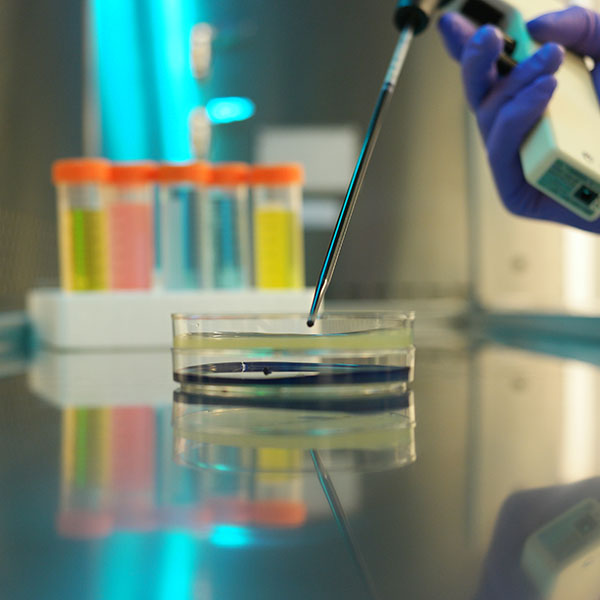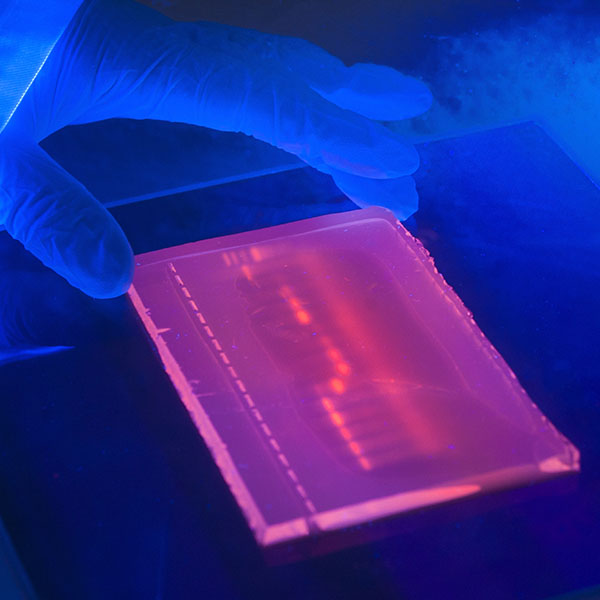| Name | Research methodologies & approaches used | Current PhD student topics |
|---|
| Dr Christine Davidson |
experimental research, quantitative analysis, method development, environmental studies.
|
development of colorimetric sensors for field applications; geochemistry of potentially toxic elements in freshwater systems; sequential chemical extraction; microplastics as vectors for potentially toxic elements in the environment; phytoremediation of contaminated soil.
|
| Professor Damion Corrigan |
electrochemical biosensors (nucleic acid, immunoassays and small molecule detection), bioelectrochemistry, DNA origami, surface attachment and bioconjugation, sensor and device fabrication
|
low-cost electrode systems, electrochemical immunoassays, nucleic acid amplification, lab-on-a-chip technologies, molecular and medical diagnostics
|
| Dr Gavin Craig |
porous molecules and composite materials; structural chemistry; crystallisation; supramolecular chemistry
|
metal-organic cages for gas storage, Cooperative gas uptake, Sustainable synthesis of porous materials
|
| Dr Lynn Dennany |
electrochemical analysis, cyclic voltammetry, electrochemiluminescence, chromatography, spectroscopic analysis.
|
illicit drug detection, biomarker recognition, bacterial infection detection, portable drug screening, pharmaceutical drug detection, combined electrochemical & spectroscopic analysis.
|
| Dr Robert Edkins |
synthesis of organic and inorganic conjugated molecules, (time-resolved) fluorescence spectroscopy, fluorescence microscopy.
|
photodynamic and photothermal therapy, fluorescent sensors, photoactive materials.
|
| Professor Karen Faulds |
Raman, surface enhanced Raman scattering (SERS), bionanotechnology.
|
SERS bionanosensors for bioanalytical detection (e.g. for cancer, bacteria, sepsis, CVD), biomedical spectroscopy, nanoparticle synthesis and biofunctionalisation, towards in vivo detection of nanobiosensors (SESORS), Raman/SERS imaging.
|
| Dr Ying Fu |
Organic bioelectronics, Organic electrochemical transistors, Biomarker detection
|
Highly sensitive organic bioelectronics, low-cost point-of-care device, Early medical diagnosis |
| Professor Duncan Graham |
nanoparticle synthesis and modification, Raman spectroscopy including Surface Enhanced Raman scattering and stimulated Raman scattering, Raman microscopy and cellular imaging
|
sensors for biomolecules relating to disease including DNA, RNA, proteins, new imaging approaches and chemical probes for cellular analysis relating to diseases including metabolic disease, cancer and liver injury.
|
| Dr Penelope Haddrill |
molecular biology, DNA profiling, RNA quantification, population genetics and genomics.
|
analysis of DNA methylation to estimate age, RNA quantification for ageing body fluid stains, population genetics and genomics of global human populations.
|
| Professor Clare Hoskins |
nanomedicine, cancer nanomedicine, therapeutics, diagnostics, theranostics, polymer synthesis, inorganic synthesis, formulation, in vitro testing
|
nanomedicine development for cancer therapeutics, theranostic development for earlier detection and treatment in cancer, drug formulation for bioavailability enhancement, targeted drug delivery systems, stimuli-responsive drug delivery systems
|
| Dr Craig Jamieson |
medicinal chemistry, organic synthesis, peptide chemistry, chemical biology |
design, synthesis and evaluation of bioactive compounds; sustainable approaches to amidation chemistry; novel biomolecular labelling techniques. |
| Dr Alan Kennedy |
X-ray diffraction, crystallography, structural analysis, solid-state analysis.
|
pharmaceutical materials, dyes and pigments, correlation of solid-state structures with material properties, solubility.
|
| Professor William Kerr |
metal-mediated synthetic organic chemistry.
|
hydrogen isotope exchange, C-H activation, natural product synthesis, asymmetric processes.
|
| Dr K H Aaron Lau |
control of peptide and peptide-mimetic (peptoid) material properties through sequence design of molecules, solid phase synthesis of peptide and peptoids, Nanostructure self-assembly (nanosheets, micelles, nanofibres), enzyme triggered self-assembly, protein separation using nanopores, HPLC, LC-MS, MALDI-MS, anodisation, surface plasmon resonance (SPR), ellipsometry, and related surface optical measurements, AFM, XPS, SEM.
|
biointerfaces, (Stem) cell-surface and protein-surface interactions, transport/diffusion of proteins through nanopores, antifouling and antimicrobial polymer brushes and nanostructures, polyphenol surface modification, protein and enzyme assays, peptide characterization.
|
| Dr John Liggat |
polymer physical chemistry, physics and technology, including adhesion, crystallisation behaviour, physical ageing, nanocomposite technology and polymer processing. Elucidation of the mechanistic organic chemistry of polymer degradation processes, particularly in relationship to polymer durability, processing and fire response.
|
physical chemistry of gelatin, fire-retardant polyurethanes, polymer photochemistry, self-healing coatings, fermentation-derived biodegradable polymers, composite materials.
|
| Dr David Lindsay |
synthetic organic chemistry, organometallic chemistry, catalysis, computational chemistry, physical organic chemistry
|
new methods for C-C, C-N and C-O bond formation, computationally-guided catalyst design for C-C bond formation
|
| Dr Lewis MacKenzie |
inorganic synthesis, solvothermal nanoparticle synthesis, powder X-ray diffraction, upconversion luminescence spectroscopy, UV-VIS spectroscopy, electron microscopy, zeta-potential analysis, dynamic light scattering analysis.
|
development of non-invasive trans-tissue biosensors based upon upconversion nanoparticles
|
| Professor Robert Mulvey |
main group chemistry, organometallic chemistry, structure and bonding, synthesis, catalysis.
|
synergistic chemistry using bimetallics; sustainable homogeneous catalysis though earth abundant metals; trans-metal trapping.
|
| Professor John Murphy |
synthetic organic chemistry, chemical mechanism, physical organic chemistry.
|
electron transfer in chemistry and biology, radical ions, super electron donors, super electrophiles, C-H activation.
|
| Dr David Nelson |
physical (in)organic chemistry, catalysis, organometallic chemistry, organic synthesis.
|
reaction mechanisms and structure/reactivity relationships in nickel catalysis; odd-numbered oxidation states of nickel in catalysis.
|
| Dr Alison Nordon |
process analysis, chemometrics, in situ measurements, optical spectroscopy, acoustics, NMR spectroscopy.
|
In situ monitoring of continuous pharmaceutical manufacturing processes, advances in chemometrics for on-line mid infrared and low-field NMR measurements, advances in data pre-processing, compression and data fusion for assessment of tea products by hyperspectral imaging, advances in data pre-processing, compression and data fusion for assessment of tea products by hyperspectral imaging, process performance monitoring for the life sciences.
|
| Dr Charles O'Hara |
synthesis, catalysis, structural elucidation.
|
main group catalytic applications; novel methodologies for the deprotonation of arenes; bimetallic asymmetric synthesis.
|
| Dr David Palmer |
theoretical and computational chemistry, molecular informatics, molecular simulation, quantum mechanics, artificial intelligence, machine learning, statistical mechanics, solution-state theory. |
molecular integral equation theory in drug discovery, protein allostery, chymosin biochemistry, artificial intelligence for molecular property prediction. |
| Dr John Parkinson |
applications using and developments of Nuclear Magnetic Resonance (NMR) Spectroscopy methods. |
complex mixture analysis, metabolic profiling, reaction process monitoring, AI in NMR, photo-active process monitoring, biomolecular structure elucidation, molecular recognition and related molecular assembly processes, venom chemistry |
| Dr Binoy Paulose |
single molecule detection, single cell biopsy, dielectrophoresis, micro/nanofabrication, nanopore sensing, scanning electrochemical probe microscopy |
amplification free detection of disease biomarkers, development of single cell biopsy platform to map dynamic transcriptional changes, dielectrophoretic nanotweezers |
| Dr Marc Reid |
computer vision, reaction monitoring, kinetic analysis, machine learning, high throughput experimentation |
software development for camera-based reaction monitoring; enhanced forensics tests with imaging technology; understanding mixing effects in catalytic hydrogenation processes; developing reactivity scales with computer vision; catalyst degradation analysis; robotics for high throughput kinetic imaging analysis |
| Dr Stuart Robertson |
inert atmosphere synthesis, Solid state and solution structure elucidation, organometallic complex design. |
secondary magnesium battery electrolyte design and synthesis, bimetallic main group chemistry. |
| Dr Fraser Scott |
medicinal chemistry, synthetic organic chemistry, biophysical measurements, antimicrobial susceptibility testing, enzyme inhibition assays.
|
design, synthesis and evaluation of novel anti-infective agents; design, synthesis and evaluation of novel anticancer agents; mechanism of action studies of minor groove binder drugs.
|
| Dr Sebastian Sprick |
porous polymers; conjugated polymers; light-driven reactions; photocatalysis
|
sustainability; solar fuels generation, hydrogen generation, water splitting; water purification
|
|
Dr Juliane Simmchen
|
colloidal synthesis and characterization, microscopy, biohybrids.
|
Active matter, Micro plastic and colloidal computation. |
| Professor Nicholas Tomkinson |
synthesis, isolation, purification and analysis of small organic molecules. |
chemical biology, medicinal chemistry, synthetic methodology. |
| Professor Christopher Tuttle |
development and application of computational methods including, density functional theory, atomistic MD simulations, coarse grain methodology, and multi scale methods. |
directed discovery of functional peptide-based materials, catalyst design, rationalising reactivity, exploiting experimental and computational chemistry synergy. |
| Dr Alastair Wark |
bioanalytical chemistry, nanotechnology, optical (Raman, fluorescence, surface plasmon resonance) and electrochemical sensors, confocal multiphoton microscopy including coherent Raman techniques, cell imaging, surface and interfacial chemistry. |
Biomolecular and environmental sensor design, disease detection, multiplexed biomarker panel analysis, nanoparticle synthesis and functionalisation, single nanoparticle tracking, multi-modal optical imaging and monitoring live cells. |
| Dr Catherine Weetman |
Inert atmosphere synthesis, Organometallics, NMR studies, DFT bonding analysis, Structure-reactivity relationships |
low-oxidation state chemistry main group chemistry, main group metal-metal bonds, main group catalysis
|







